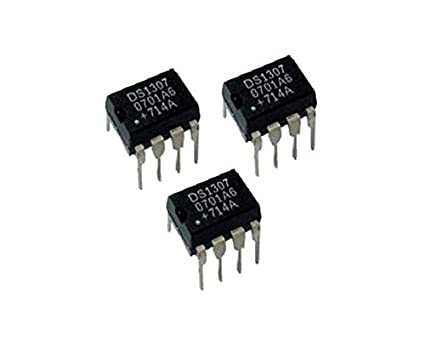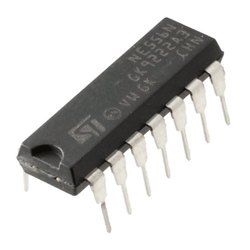DS1230Y-70+
The DS1230 256k Nonvolatile SRAMs have a capacity of 262,144 bits and are structured as 32,768 words by 8 bits. Each NV SRAM contains its own lithium energy source as well as control circuitry that constantly monitors VCC for out-of-tolerance conditions. When this occurs, the lithium energy source is automatically activated, and write protection is enabled unconditionally to avoid data corruption. The DS1230 DIP-package devices can be utilized in place of current 32k ? 8 static RAMs that directly comply to the common byte wide 28-pin DIP standard. The pinout of the DIP devices matches that of the 28256 EEPROMs, allowing for straightforward substitution while improving performance. The Low Profile Module package of DS1230 devices is specifically suited for surface-mount applications. There is no limit to the number of write cycles that can be performed.
DS1232 MicroMonitor Chip
DS1232 Micro Monitor? Chip monitors three vital conditions for a microprocessor: power supply, software execution, and external override. First, a precision temperature-compensated reference and comparator circuit monitors the status of VCC. When an out-of-tolerance condition occurs, an internal power fail signal is generated which forces reset to the active state. When VCC returns to an in-tolerance condition, the reset signals are kept in the active state for a minimum of 250 ms to allow the power supply and processor to stabilize.
The second function the DS1232 performs is push button reset control. The DS1232 debounces the push button input and guarantees an active reset pulse width of 250 ms minimum. The third function is a watchdog timer. The DS1232 has an internal timer that forces the reset signals to the active state if the strobe input is not driven low prior to timeout. The watchdog timer function can be set to operate on timeout settings of approximately 150 ms, 600 ms, and 1.2 seconds.
DS1232 Datasheet
DS12C887 IC – Real Time Clock (RTC) IC
RTC DS 12C887 is widely used to provide exact time and date in many applications such as x86 IBM PC. This RTC provides time components hour, minute and second in addition to the date/calendar components of year, month and day. This chip uses an internal lithium battery, which keeps the time and date updated even when the power is off. The DS12C887 works on CMOS technology to keep the power consumption low. It has a total of 128 bytes of non volatile RAM. It uses 14 bytes of RAM for storing the values of clock/calendar and control registers. The rest 114 bytes of RAM are for general purpose data storage.
The internal registers are accessible only when the RTC is powered by an external power source. When the external power is turned off, the RTC clock keeps running from the internal lithium battery source but the internal registers of the RTC cannot be accessed. RTC 12C887 becomes active when a voltage greater than 4.25V is applied and the internal registers can be accessed after 200 msec.
DS12C887+
The real-time clocks (RTCs) DS12885, DS12887, and DS12C887 are intended to be straight replacements for the DS1285 and DS1287. The devices have a real-time clock/calendar, one time-of-day alarm, three maskable interrupts with a shared interrupt output, a programmable square wave, and 114 bytes of battery-backed static RAM (113 bytes in the DS12C887 and DS12C887A). In a 24-pin enclosed DIP device, the DS12887 incorporates a quartz crystal and a lithium energy supply. At address 32h, the DS12C887 adds a century byte. For all devices, the end-of-month date is automatically modified for months with fewer than 31 days, including leap years. The devices can also be set to operate in 24-hour or 12-hour mode and have an AM/PM indicator. The status of VCC is monitored using a precision temperature-compensated circuit. If the primary power supply fails, the device immediately switches to a backup supply. When primary power is not available, a lithium coin-cell battery can be attached to the DS12885's VBAT input pin to keep the time and date running. The device is addressed via a multiplexed byte-wide interface that supports both Intel and Motorola modes of operation.
DS1307 IC – Real Time Clock (RTC) IC
The DS1307 Serial Real-Time Clock is a low-power, full binary-coded decimal (BCD) clock/calendar plus 56 bytes of NV SRAM. Address and data are transferred serially via a 2-wire, bi-directional bus. The clock/calendar provides seconds, minutes, hours, day, date, month, and year information. The end of the month date is automatically adjusted for months with fewer than 31 days, including corrections for leap year. The clock operates in either the 24-hour or 12-hour format with AM/PM indicator. The DS1307 has a built-in power sense circuit that detects power failures and automatically switches to the battery supply.
DS3231S – IC
DS3231 IC is a low-cost, extremely accurate I?C real-time clock (RTC) with an integrated temperature compensated crystal oscillator (TCXO) and crystal. The device incorporates a battery input and maintains accurate timekeeping when the main power to the device is interrupted. The integration of the crystal resonator enhances the long-term accuracy of the device as well as reduces the piece-part count in a manufacturing line.
The DS3231 is available in commercial and industrial temperature ranges and is offered in a 16-pin, 300-mil SO package.
NE555 Timer IC DIP-8 Package
The NE555 IC devices are precision timing circuits capable of producing accurate time delays or oscillation. In the time delay or monostable mode of operation, the timed interval is controlled by a single external resistor and capacitor network. In the a stable mode of operation, the frequency and duty cycle can be controlled independently with two external resistors and a single external capacitor. The threshold and trigger levels normally are two-thirds and one-third, respectively, of VCC. These levels can be altered by use of the control-voltage terminal. When the trigger input falls below the trigger level, the flip-flop is set, and the output goes high. If the trigger input is above the trigger level and the threshold input is above the threshold level, the flip-flop is reset and the output is low. The reset (RESET) input can override all other inputs and can be used to initiate a new timing cycle. When RESET goes low, the flip-flop is reset, and the output goes low. When the output is low, a low impedance path is provided between discharge (DISCH) and ground. The output circuit is capable of sinking or sourcing current up to 200 mA. Operation is specified for supplies of 5V to 15V. With a 5-V supply, output levels are compatible with TTL inputs.
NE556 IC – Dual Timer IC
NE556 IC devices provide two independent timing circuits of the NE555 ?type in each package. These circuits can be operated in the a stable or the monostable mode with external resistor-capacitor (RC) timing control. The basic timing provided by the RC time constant can be controlled actively by modulating the bias of the control-voltage input. The threshold (THRES) and trigger (TRIG) levels normally are two-thirds and one-third, respectively, of VCC. These levels can be altered by using the control voltage (CONT) terminal. When the trigger input falls below trigger level, the flip-flop is set and the output goes high. If the trigger input is above the trigger level and the threshold input is above the threshold level, the flip-flop is reset, and the output is low. The reset (RESET) input can override all other inputs and can be used to initiate a new timing cycle. When RESET goes low, the flip-flop is reset and the output goes low. When the output is low, a low-impedance path is provided between the discharge (DISCH) terminal and ground (GND).
NE556 IC Datasheet
















